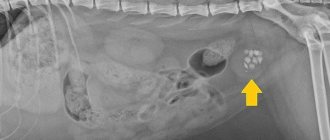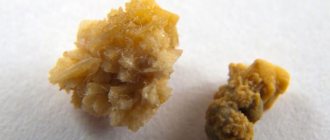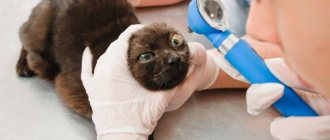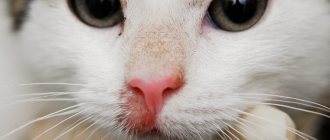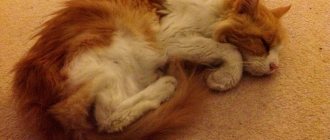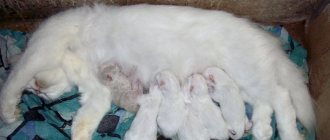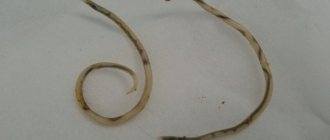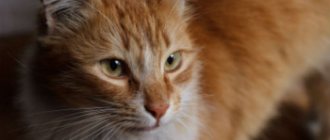The appearance of sand or stones in the urinary organs of your beloved cat is an unpleasant, but not uncommon phenomenon. This pathology is dangerous due to its unpredictable course and requires an immediate response. Urolithiasis is difficult to diagnose at home. Purring owners need to have at least minimal knowledge about the symptoms of this process. Then it will be easier to suspect and treat the painful condition.
Life story...
As an introduction, here is a real incident that happened several years ago...
The ambulance was flying through the city at night, cutting through the darkness with its headlights. An ordinary challenge that doesn’t stand out in any way from a series of hundreds of others. Male, forty-two years old, acute pain in the lumbar region. The doctor looked at the call sheet, weighing a possible diagnosis in his head. The car ran its headlights along the wall of the house, turning into the yard. In the faint light of the lantern one could see a well-groomed courtyard with a children's swing and a flowerbed. The ambulance stopped at the right entrance. Grabbing his suitcase, the doctor hurriedly ran up the steps and dialed the number on the intercom. The elevator took him to the sixth floor, where a pretty, fragile woman was already waiting for him, chillyly wrapped in a coat thrown over her shoulders.
The doctor entered the apartment, hastily washed his hands and, wiping them with a towel as he went, walked into the room. The man was lying on the sofa, the rumpled sheets indicating that he had apparently recently had a seizure. Now, apparently, the pain had subsided and he, gradually coming to his senses, squinted, trying to see the doctor’s face. The doctor said hello, sat down on the edge of the sofa and, asking the usual questions about complaints, threw back the blanket. The patient's entire abdomen, thighs and back were covered with small bruises. The doctor looked at the man in confusion:
- Who are you? “Wife,” answered the patient. - Is she hitting you? – the doctor asked in complete confusion, glancing sideways at the pretty woman standing next to him. - It stings. - Does it sting? For what?? The patient sighed and weakly waved his hand. “Doctor, he has a kidney stone,” the woman explained. “We were told that if you pinch it, it can come out on its own...
Kidney suffering
People suffering from urolithiasis (KD) say: “If you have not experienced an attack of renal colic, then you do not know what real pain is!” Indeed, kidney stones, as well as inflammatory processes in the organs of the urinary system, cannot be classified as minor diseases.
Normal activity of all organs and systems is possible only if “toxic” metabolic products are promptly removed from the body. This function is performed by the large intestine, liver, skin, but mainly by the kidneys. If the kidneys cannot cope with their function due to illness, the entire body, all organs and systems suffer.
Causes of ICD
There are many factors that contribute to the development of urolithiasis. All reasons are conventionally divided into external and internal. In this case, a combination of several provoking conditions is possible.
Exogenous
External causes are related to the living conditions, activity, and nutrition of the cat. One of the first places is irrational nutrition. An imbalance of proteins, fats, and carbohydrates leads to a shift in urine pH to the acidic or alkaline side. In both cases, solid conglomerates begin to form in the urinary organs. Vitamin deficiencies are also related to diet. All biologically active substances are important, but this is most true for vitamins A and D. Vitamin deficiency leads to metabolic disorders.
Thirdly, the lack of water and/or the high saturation of the liquid with minerals affects it. This factor affects the concentration of urine. In a more saturated liquid, solid inclusions form faster. The need for water increases if the cat lives in hot home conditions.
For some scrupulous cats, the cleanliness of the tray is important. Dirty litter makes the animal endure. Retention of urination provokes and accelerates stone-forming processes in the urine. In this case, signs of the disease appear faster.
Urolithiasis in cats is most often recorded at the very beginning of autumn, as well as in January-April.
Endogenous
Hormonal disorders can lead to the development of urolithiasis in cats. Internal causes also include diseases of the digestive system. If the food contains enough nutritional and biologically active compounds, but the cat has intestinal problems, the valuable substances will be poorly absorbed by the body. It is endogenous reasons that explain why cats of one breed or another are prone to urolithiasis. A set of genes, changes in their activity or structure influence the occurrence and rate of progression of urolithiasis in cats.
Do you like salty foods? Be carefull!
Due to metabolic disorders in the body, conditions are created for the precipitation of salts, from which stones are formed. This disrupts the flow of urine, which, in turn, leads to a disease called urolithiasis.
The formation of stones is facilitated by long-term consumption of foods containing large amounts of mineral salts, as well as stagnation of urine in the urinary tract - kidneys, ureters, bladder. Depending on the composition, the stones differ in their origin. Thus, uric acid (urate) stones are formed from uric acid salts, oxalate stones from calcium oxalate, and calcium phosphate stones from calcium and phosphate salts. Stones can grow to very large sizes, sometimes repeating the outlines of the renal pelvis and having a coral shape.
Mechanisms of urolith formation
The mechanisms responsible for the formation of stones in the urinary system in cats have not yet been fully studied. However, three main operating factors are known:
- First, an inorganic or protein matrix is formed - a kind of “skeleton”, on which a urolith crystal will subsequently grow.
- Crystallization catalysts . Organic and inorganic compounds that can accelerate the process of precipitation of compounds dissolved in urine. The more there are and the more powerful they are, the faster the disease progresses.
- Factors of crystallization . As in the previous case, these are complex organic and inorganic compounds that can accelerate or slow down the processes of precipitation and crystallization.
Regardless of all the factors described above, if the urine itself contains few elements that, at least theoretically, can precipitate, crystal formation will not occur. In the most unfavorable case for the animal, in such a situation a small amount of fine sand may form, which will not threaten the health of the pet. For “special” stones (for example, struvite, urate), there must be additional favorable conditions for formation (for example, a suitable urine pH). Note that in sterilized cats, unlike castrated cats, the disease develops much less frequently. Changes in the body's hormonal levels clearly benefit them.
Wandering stones. How to recognize them?
Stones often form in the kidneys, from where they can travel to the ureters and bladder. Manifestations of urolithiasis depend on the location of the stone. Thus, kidney stones cause pain in the lumbar region, usually aching, aggravated by physical activity and, especially, by shaking. Patients, mistaking this pain for so-called “lumbago”, often do not consult a doctor and treat themselves. Meanwhile, stones, remaining in the renal pelvis for a long time, gradually cause its expansion and inflammation of the renal tissue (pyelonephritis), block the outflow of urine from the renal pelvis and can cause an attack of severe pain (renal colic). In this case, nausea and vomiting appear, cold sweat appears, the stomach is swollen, and sometimes the temperature rises. The passage of a stone from the kidney into the ureter is accompanied by increased pain; it radiates to the genitals and groin area; there is a frequent urge to urinate.
Bladder stones cause irritation and inflammation of the bladder mucosa, manifested by frequent painful urination (so-called cramps). During physical activity or walking, the stone can injure the mucous membrane and cause bleeding with corresponding staining of the urine (hematuria). When a stone enters the urethra, an obstruction to the outflow of urine occurs. Stones in both kidneys or ureters can cause complete cessation of urine output (anuria). This is a dangerous complication, since “toxic” metabolic products accumulate in the body, and self-poisoning occurs.
Occlusion of the urethra by uroliths
This type of KSD is rare in cats, since in more than 80% of cases it develops in cats. This is due to the structural features of their genitourinary system, where there is an S-shaped bend of the urethra. Both small pebbles and large fractions of sand often get stuck in this very S. The pathology is extremely dangerous, occurs suddenly and often leads to death. To slow down the process and gain time to deliver the pet to the clinic, Papaverine is sometimes used: it lowers blood pressure, as a result of which urine production slows down.
At first, the animal may often try to urinate, as a result of which it manages to squeeze out a thin stream of red urine. Sometimes drops of pure blood begin to come out of the urethra. At the same time, the pet is far from calm: the cat meows terribly and hoarsely and even wheezes from severe pain. Complete blockade causes the development of uremia within 36–48 hours, which is accompanied by depression, anorexia, vomiting, diarrhea, dehydration, and coma. Death occurs within ~72 hours. So if you see similar signs in your pet, call your veterinarian immediately.
Uric acid, cystine, oxalate...
As we have already said, kidney stones are very different in structure - uric acid, cystine, oxalate... Determining which mineral you have grown inside is important! At least in order to free yourself from the existing stone and try to avoid the formation of new ones.
Diagnosis of urolithiasis is carried out using ultrasound or intravenous urography. Using intravenous urography, the doctor takes several x-rays of the urinary system. To do this, a radiopaque substance is injected into the bloodstream, which spreads throughout the body until it reaches the kidneys, through which it is discharged through the ureters into the bladder.
Treatment of urolithiasis at home
If you notice signs of urolithiasis in your cat, you should immediately contact the veterinary clinic. But you can use some home remedies to alleviate the symptoms. They help make the suffering animal feel better. A warm heating pad is placed on the stomach. After visiting the veterinary clinic, the owner’s duties include careful care of the animal. He is provided with only home conditions; walks are temporarily canceled. Great importance is attached to food, purified water, a clean tray, and compliance with the schedule for taking medications prescribed for treatment.
If you have urolithiasis, you should not massage your stomach in an attempt to relieve pain or speed up the progression of stones!
Silence is not always golden?
For a long time, the stone may not show itself in any way. But this is not dangerous only in those rare cases when stones can be considered “clinically insignificant” - they are not only “silent”, but also do not impair kidney function for many years. However, everything is for the time being, so such patients need to periodically visit a urologist.
A kidney stone makes itself felt with an attack of renal colic. When it happens depends not at all on its size, as many people think, but on where exactly the stone settled, whether it blocked the outflow of urine and other factors.
Diet therapy
If the animal's condition is relatively stable, special feeding may be used. Its goal is to reduce urine pH to <6. Today, by the way, many commercial feeds are produced (we will write about some of them below) that help quickly solve this problem. You need to reduce your daily intake of protein, phosphates, magnesium and sodium . If everything is done correctly, the daily reproduction of urea will sharply decrease, but urine production, on the contrary, will increase. As a result, fine sand and stones will simply be washed out of the urinary system or (over time) dissolved.
There is one “subtlety”. During this time, your cat should not eat anything other than the diet prescribed by your veterinarian. Otherwise, no positive effect will be achieved.
To make your pet’s life more “colorful” and not starve him, you can use any medicinal food from Royal Canin, Purina and others like them.
Such diets are developed specifically for weakened animals and are recommended for use during the period of rehabilitation after serious illnesses, as well as for feeding pets with urolithiasis.
To ensure nutritional appeal for cats with weakened immune systems, when developing food, the taste characteristics of these animals were taken into account; the food is saturated with flavoring compounds that help awaken the pet’s appetite. The products contain easily digestible oligosaccharides and fats. The high nutritional value that they possess allows you to give the animal a smaller amount of feed, but at the same time fully provide its daily need for nutrients, micro and macroelements, and vitamins.
In addition to simple oligosaccharides, beet pulp is used in the production of the product. It is a source of complex carbohydrates and fiber that stimulate intestinal peristaltic activity. What if you don’t have the opportunity to give your pet something similar?
Before it’s too late, drink Borjomi!
There is no point in relying on medications that dissolve kidney stones. Today, despite the assurances of various commercials, there are no drugs that can dissolve formed oxalate and phosphate kidney stones (and these are the ones that occur in most patients). Only uric acid stones (urates) can be dissolved, and then only in some cases.
The mineral waters of our resorts can be recommended as a treatment only if the stone is small and can therefore easily be removed from the body. And what you definitely shouldn’t do is go to a resort against the opinion of a doctor who is offering you surgical removal of the stone. Moreover, today very gentle operations are possible.
Shock wave - over stones
ESWL
- Cost: 49,000 rub.
- Duration: 40-90 minutes
- Hospitalization: 1 day in hospital
More details
Over the past 10 years, due to the widespread introduction of modern technologies for removing stones from the kidneys and urinary tract into urological practice, the strategy and tactics of treating this disease have changed significantly. Today, kidney stones can be crushed, and this method - extracorporeal lithotripsy (ESLT) - is widely used in many urological clinics in Russia. It allows you to minimize the severe complications that were observed during open operations. It has become possible to get rid of kidney stones in patients who have had a heart attack, stroke, angina pectoris, coronary heart disease and other diseases.
As already mentioned, extracorporeal lithotripsy has rightfully taken a leading place in the treatment of kidney and ureteral stones. This simple, low-traumatic method of treating stones is the method of choice along with endoscopic and open surgical interventions. The use of extracorporeal lithotripsy is especially effective for relatively small stones and preserved functions of the affected kidney. At the same time, in addition to DLT, new surgical methods have been mastered and continue to be developed, allowing in most cases to avoid open surgery and achieve the desired result with less risk to the patient. These include various endourological operations. The main criterion for choosing a method for endoscopic stone destruction is the size, shape, position and duration of the stone's presence in the ureter.
Urologists at the Center for Endosurgery and Lithotripsy were among the first in the country to include a gentle method of non-contact crushing of stones - remote lithotripsy - in the complex of treatment of urolithiasis: when stones are localized in the kidneys or ureters, the patient does not require surgical intervention, except in cases with a large stone size. In this situation, two options for surgical treatment of urolithiasis are possible: endoscopic or traditional (open) surgery. The specialists of the urological department of our clinic are proficient in all of the listed methods of treating urolithiasis. Such a volume of endoscopic urological care, which is provided to patients at CELT, is not available in almost any medical institution, including highly specialized ones.
Prevention and more prevention
As already mentioned, the main cause of the development of the disease is an inborn error of metabolism. Therefore, if many of your relatives suffer from this disease, you better be attentive to yourself and adhere to the following recommendations:
- Do not consume : broths, chocolate, coffee, cocoa, spicy and fried foods.
- Limit : the total amount of food (do not overeat), consumption of fatty foods, table salt.
- Drink a lot of water, at least 1.5 liters. per day. In summer you should drink enough to never feel thirsty.
- Regularly take diuretic infusions or decoctions of various herbs.
- Do not get too cold, always keep your lower back warm.
- If you experience even slight discomfort in the lumbar region, immediately contact a urologist.
As for the “pinched” patient, whom we talked about at the very beginning, he, of course, got help. The stone was crushed, and so carefully that only the slowly disappearing bruises from the extravagant method of self-medication that he had invented reminded him of his recent illness.
